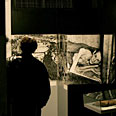
Only few fighters survived Nieswiez Ghetto uprising. Yad Vashem (archives)
Photo: Reuters
When one thinks of a ghetto uprising,
the first thing that comes to mind is Warsaw. But historians have already determined that the Warsaw Ghetto fighters were not the first to revolt against the Nazis – they were preceded by the fighters of the Nieswiez Ghetto in eastern Poland.
"Today, there is not a single remnant of the revolt which can tell what happened there. So I am telling it, because they deserve the historical accuracy. They deserve the honor. They fought and fulfilled their slogan, 'Let me die with the Philistines,'" says Noah Shklar, who was born in Nieswiez.
In order to create awareness and honor the ghetto fighters, an event marking the ghetto will be held Monday evening at the Yad Vashem Holocaust Museum.
Unique Images
As part of his job as 'special military reporter,' Hugo Jaeger got to use advanced color photography during World War II. His work includes unique documentation of Jews in Warsaw, Kutno ghettos
Shklar, 95, was drafted by the Russian army when the town was annexed by the Soviet Union following the Molotov–Ribbentrop Pact.
"I wasn't at the ghetto when the Germans conquered the town, nor was I there during the uprising," he clarifies. But he did keep in touch with his friends who survived the ghetto and told him what had happened. "Yad Vashem historians have already determined that the revolt in our ghetto was the first, but I doubt anyone knows that on the street."
During Monday evening's seminar at the Yad Vashem Museum marking the uprising, Shklar is expected to recount everything he knows about his friends' revolt.
The Nazis invaded the town on June 28, 1941. Some 4,000 Jews were murdered in the first operation, on October 30, 1941. Some 600 craftsmen remained. They later set up the ghetto, and from its first day youth movement activists and teachers decided that the operation would not repeat itself and that they would revolt.
One of the rebels' leaders was Chaim Polchek, a chemistry teacher, who was in charge of the preparation of Molotov cocktails.
The uprising broke out on July 21, 1942. "The Germans came in and tried to make another selection, but the underground committee members said, 'Either everyone stays or everyone goes.' That’s when the battle began.
"The brave fighters used everything they could get their hands on, the few weapons they obtained, a hoe or a knife. Most of them were killed, including Polchek. Only 14 fighters survived. According to sources, they managed to kill 40 Germans. The uprising lasted an entire day."
Dr. Lea Preiss, who edited the Hebrew online edition of Yad Vashem's Encyclopedia of the Ghettos, adds that "the Jews in the ghetto who decided not to surrender established an underground against the will of the head of the Judenrat (administrative bodies which the Nazis required Jews to form in the German-occupied territory).
"When they found out that another operation was planned, they decided to fight. Few survived and managed to escape, and some joined the partisans."















